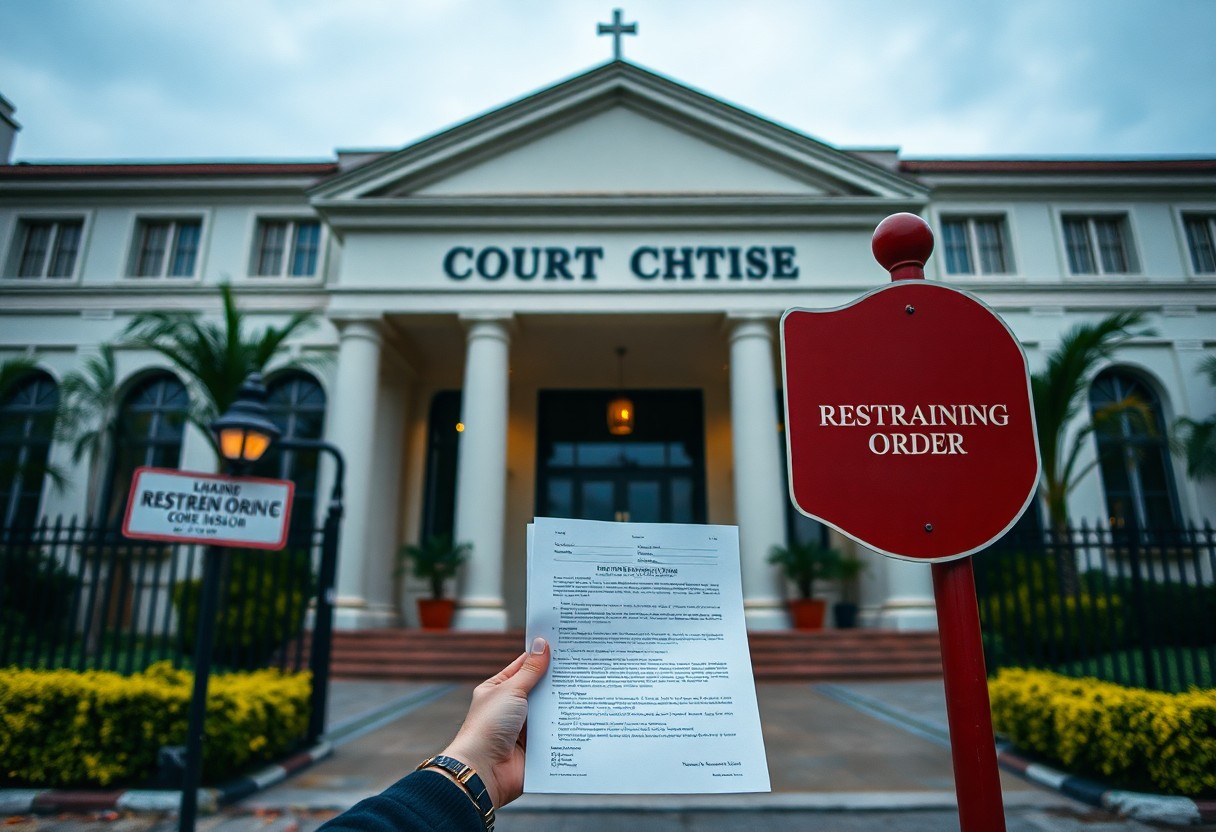Just knowing how to protect yourself is vital, especially if you feel threatened. Obtaining a restraining order can be a significant step toward ensuring your safety and peace of mind. If you are dealing with harassment or violence, it’s important to act promptly. This guide will walk you through the process, addressing legal steps and necessary documentation needed. If your situation involves Domestic Violence, seeking help from local authorities and legal professionals is highly recommended. Your safety matters, and taking action can lead to a positive outcome.
Key Takeaways:
- Determine if you qualify for a restraining order based on the nature of the threat or harassment.
- Gather necessary documentation, including evidence of incidents and details about the offender.
- Visit the nearest court in Klang to obtain the appropriate forms for filing a restraining order.
- Complete the forms accurately and include all relevant information to support your case.
- File the completed forms with the court clerk and pay any applicable fees, if required.
- Attend the court hearing when scheduled, presenting your case clearly and concisely to the judge.
- Understand the terms of the restraining order and the process for enforcement if violated.

Understanding Restraining Orders
A restraining order is a legal tool designed to protect individuals from harassment, abuse, or threats. They serve as a preventive measure that prohibits another person from coming near you or contacting you in any manner. Understanding how restraining orders work is necessary for anyone needing protection and seeking to navigate the legal system effectively.
Definition and Purpose
There’s a need for restraining orders when an individual’s safety is at risk. These legal orders aim to prevent the perpetrator from engaging in unwanted behaviors, allowing you to feel secure in your daily life. They are enforced by law enforcement, ensuring compliance.
Types of Restraining Orders
While there are various types of restraining orders, each serves a specific purpose to cater to different situations. Understanding these types is vital in selecting the most suitable protection for your circumstances.
| Type of Restraining Order | Description |
|---|---|
| Temporary Restraining Order (TRO) | Provides immediate protection until a court hearing can be held. |
| Permanent Restraining Order | Issued after a court hearing, offering long-term protection. |
| Emergency Restraining Order | Granted in urgent situations without prior notice to the offender. |
| No-Contact Order | Prevents the offender from contacting you through any means. |
| Civil Restraining Order | Applicable in non-criminal situations, often involving family disputes. |
Another aspect of restraining orders includes the process of obtaining them and the variations you might encounter. It’s important to be aware of how the type you choose will impact your situation. Each type addresses specific issues and concerns related to your safety.
- Understanding the type that best fits your needs is vital.
- Collecting evidence will strengthen your case when applying.
- Filing correctly with the court will ensure you avoid delays.
- Following legal procedures is necessary for enforcement.
- Seeking legal assistance can make the process smoother.
Any of these details may have significant implications for the protective scope of your restraining order.

Eligibility Criteria
Any individual seeking protection from harassment, threats, or violence can apply for a restraining order. This includes victims of domestic violence, stalking, or any situation where you feel your safety is compromised. It is necessary that you can demonstrate a reasonable fear for your safety and well-being, as this forms the basis of your eligibility.
Who Can Apply
Little do many know, almost anyone can apply for a restraining order if they feel threatened. This includes not only direct victims but also guardians applying on behalf of minors. Whether the concern arises from a partner, family member, or acquaintance, your circumstances can support a valid application.
Necessary Documentation
Assuming you decide to apply, you will need to gather specific documentation to support your request. This could include police reports, photographs of injuries, messages or communication that demonstrate harassment, and witness statements that corroborate your claims.
Understanding what documents are required is vital for a solid application. Firstly, make sure to collect any evidence like text messages, emails, or social media communications that illustrate the threat. Additionally, eyewitness statements or police reports can bolster your case significantly. If you’ve sought medical attention due to any incidents, medical records documenting your injuries will also be important. Having your documentation organized will aid in illustrating the seriousness of your situation and can lead to a more favorable outcome for your restraining order request.
Steps to File for a Restraining Order
Now that you understand the importance of a restraining order, it’s vital to know the necessary steps to file one effectively. This process involves preparing your application, submitting it to the appropriate court, and ensuring that you follow up on the necessary proceedings to secure your safety.
Preparing Your Application
There’s a structured approach to completing your application for a restraining order. You will need to gather all relevant evidence, such as any documentation or photographs that support your claim. Additionally, be prepared to write a clear account of the incidents that have led you to seek legal protection, as this will significantly strengthen your case.
Submitting the Application
Preparing your application is only half the process; the next step is to submit it to the appropriate court in Klang. You can typically file your application at the local magistrate’s court or family court, depending on your circumstances. It’s important to pay attention to any specific requirements or fees that may apply.
Your application will go through a review process once submitted. Ensure that you’ve completed all necessary forms accurately and included any attachments that support your case. The court may require you to provide evidence of immediate danger, so presenting a compelling case is important. Stay aware of any hearing dates that are set and keep all appointments to avoid delays in securing your protection.
Tips for a Successful Application
Despite the challenges you may face, following these tips can help ensure a successful application for a restraining order in Klang:
- Be clear and concise about your situation.
- Provide detailed accounts of incidents related to the harassment.
- Gather supporting evidence such as photographs and messages.
- Be honest about your experiences and feelings.
This approach can significantly aid your case.
Gathering Evidence
Assuming you want to strengthen your application, collecting evidence is important. Document every instance of harassment, including dates, times, and descriptions of events. You can also take photographs of any injuries or damage, and keep copies of text messages, emails, or social media interactions that illustrate the behavior you wish to report.
Seeking Legal Advice
Tips for your application process include consulting with a legal professional. They can help you navigate the complexities of the legal system and provide vital insights about your rights and options.
Application for a restraining order can be complicated, and having a lawyer who specializes in family law or personal safety can make a positive impact. They will guide you through the process, ensuring that your application is filled correctly while highlighting the dangerous aspects of your situation that necessitate protection. Engaging a lawyer boosts your chances of success significantly by ensuring all necessary details are covered properly.
Factors Influencing the Decision
All restraining orders are carefully assessed by the courts, considering various factors that influence their decision. Important elements include:
- Nature of the threat
- Relationship between parties
- Evidence provided
- History of violence
Knowing these factors can help you present a stronger case when applying for a restraining order.
Nature of the Threat
Factors such as the severity and immediacy of the threat play a significant role in your application. The court will evaluate if the threat is direct, explicit, and established through actions or communications, affecting the urgency of the situation and their subsequent decision.
Relationship Between Parties
Nature of your relationship with the individual you seek protection from can influence the court’s decision. If the parties share a background, such as being family members, spouses, or in a significant dating relationship, the court may assess the threats with a higher level of scrutiny. Understanding the dynamics of your relationship can also highlight risks or control mechanisms that may exist, thus playing a vital role in successfully obtaining the restraining order.
Decision regarding restraining orders is often impacted by the history of the relationship between you and the individual involved. If you’ve experienced repeated patterns of abuse, the court is likely to view your situation with heightened concern. Moreover, previous police reports or documented incidents can enhance the credibility of your claims. Understanding the relationship’s context allows you to present evidence effectively, making it crucial for your protective measures to be taken seriously.

Preparing for the Hearing
Not only is it imperative to gather all necessary documents, but you should also mentally prepare yourself for the hearing. This includes reviewing the details of your case and being ready to articulate your needs and concerns clearly. Organizing your evidence and perhaps practicing your statements can bolster your confidence during the proceedings.
What to Expect
The hearing will typically involve you presenting your case to a judge, along with any evidence or witness statements you have gathered. Be prepared for the other party to be present and potentially contest your application. The judge will ask questions and make a decision based on the information presented.
Key Points to Address
On the day of the hearing, focus on specific incidents that led you to seek the restraining order, establishing a clear pattern of behavior that poses a threat to your safety. It’s important to articulate your feelings of fear and the impact on your daily life, while also providing any relevant supporting evidence such as texts, photos, or witness testimonies.
Understanding these key points will enhance your ability to effectively communicate your situation during the hearing. Providing specific examples of threatening behavior, as well as detailing how this affects your physical and emotional well-being, can underscore the reasons behind your request. Be sure to articulate any instances where you felt unsafe and highlight any efforts you made to resolve the situation before seeking the restraining order. This evidence will support your assertion that the order is necessary for your protection.
Summing up
Considering all points, obtaining a restraining order in Klang involves understanding the legal process and following specific steps to ensure your safety. You must gather necessary documentation, fill out the application at the appropriate court, and present your case clearly. Consulting with a legal expert can further assist you in this process. For additional guidance, you can refer to the article on Protection order made easy. By being informed and prepared, you can take effective steps to protect yourself.
FAQ
Q: What is a restraining order?
A: A restraining order is a legal order issued by a court to protect an individual from harassment, stalking, or any form of abuse by another person. It prohibits the abuser from making contact or approaching the victim.
Q: Who can apply for a restraining order in Klang?
A: Any individual who feels threatened, harassed, or abused can apply for a restraining order in Klang. This includes victims of domestic violence, stalking, or those who have been subjected to harassment by another individual.
Q: What steps are involved in applying for a restraining order in Klang?
A: The process typically involves the following steps: 1) Gather necessary evidence of harassment or abuse, such as photographs, text messages, or witness statements; 2) Complete a restraining order application form at the local court; 3) Submit the application along with any supporting documents; 4) Attend a hearing where both parties will present their case; 5) If granted, the court will issue a restraining order specifying the terms and duration.
Q: How long does it take to obtain a restraining order in Klang?
A: The timeline can vary. Generally, if the application is filed properly and the court is able to schedule a hearing promptly, an interim restraining order may be issued within a matter of days. The final order may take longer, depending on various factors, including court schedules and the complexity of the case.
Q: What should I bring to court when applying for a restraining order?
A: It is necessary to bring any evidence that supports your case, including photographs, text messages, voicemails, or a journal documenting the incidents. You should also have identification and any necessary forms completed for the court process.
Q: What happens if the restraining order is violated?
A: If the restraining order is violated, the victim should report the incident to the police immediately. Violating a restraining order is considered a serious offense and can result in criminal charges against the offender, including fines or imprisonment.
Q: Can a restraining order be modified or revoked?
A: Yes, a restraining order can be modified or revoked. If circumstances change or if the victim believes that the order is no longer necessary, they can file a motion with the court to alter or lift the restraining order. A hearing will be held to evaluate the request.
